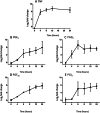SILAC-based quantitative proteomics to investigate the eicosanoid associated inflammatory response in activated macrophages
- PMID: 36050729
- PMCID: PMC9438320
- DOI: 10.1186/s12950-022-00309-8
SILAC-based quantitative proteomics to investigate the eicosanoid associated inflammatory response in activated macrophages
Abstract
Background: Macrophages play a central role in inflammation by phagocytosing invading pathogens, apoptotic cells and debris, as well as mediating repair of tissues damaged by trauma. In order to do this, these dynamic cells generate a variety of inflammatory mediators including eicosanoids such as prostaglandins, leukotrienes and hydroxyeicosatraenoic acids (HETEs) that are formed through the cyclooxygenase, lipoxygenase and cytochrome P450 pathways. The ability to examine the effects of eicosanoid production at the protein level is therefore critical to understanding the mechanisms associated with macrophage activation.
Results: This study presents a stable isotope labelling with amino acids in cell culture (SILAC) -based proteomics strategy to quantify the changes in macrophage protein abundance following inflammatory stimulation with Kdo2-lipid A and ATP, with a focus on eicosanoid metabolism and regulation. Detailed gene ontology analysis, at the protein level, revealed several key pathways with a decrease in expression in response to macrophage activation, which included a promotion of macrophage polarisation and dynamic changes to energy requirements, transcription and translation. These findings suggest that, whilst there is evidence for the induction of a pro-inflammatory response in the form of prostaglandin secretion, there is also metabolic reprogramming along with a change in cell polarisation towards a reduced pro-inflammatory phenotype.
Conclusions: Advanced quantitative proteomics in conjunction with functional pathway network analysis is a useful tool to investigate the molecular pathways involved in inflammation.
Keywords: Gene ontology; Inflammation; Prostaglandins; Proteomic; RAW 264.7.
© 2022. The Author(s).
Conflict of interest statement
The authors declare that they have no competing interests.
Figures






Similar articles
-
Cooperation of liver cells in health and disease.Adv Anat Embryol Cell Biol. 2001;161:III-XIII, 1-151. doi: 10.1007/978-3-642-56553-3. Adv Anat Embryol Cell Biol. 2001. PMID: 11729749 Review.
-
Real time changes in the expression of eicosanoid synthesizing enzymes during inflammation.Prostaglandins Other Lipid Mediat. 2024 Oct;174:106839. doi: 10.1016/j.prostaglandins.2024.106839. Epub 2024 Apr 26. Prostaglandins Other Lipid Mediat. 2024. PMID: 38679226
-
Modeling of eicosanoid fluxes reveals functional coupling between cyclooxygenases and terminal synthases.Biophys J. 2014 Feb 18;106(4):966-75. doi: 10.1016/j.bpj.2014.01.015. Biophys J. 2014. PMID: 24559999 Free PMC article.
-
Candida albicans induces pro-inflammatory and anti-apoptotic signals in macrophages as revealed by quantitative proteomics and phosphoproteomics.J Proteomics. 2013 Oct 8;91:106-35. doi: 10.1016/j.jprot.2013.06.026. Epub 2013 Jul 5. J Proteomics. 2013. PMID: 23832136
-
Cytochrome P450-derived eicosanoids: the neglected pathway in cancer.Cancer Metastasis Rev. 2010 Dec;29(4):723-35. doi: 10.1007/s10555-010-9264-x. Cancer Metastasis Rev. 2010. PMID: 20941528 Free PMC article. Review.
References
-
- Sabido E, Quehenberger O, Shen Q, Chang CY, Shah I, Armando AM, Andreyev A, Vitek O, Dennis EA, Aebersold R. Targeted proteomics of the eicosanoid biosynthetic pathway completes an integrated genomics-proteomics-metabolomics picture of cellular metabolism. Mol Cell Proteomics. 2012;11:M111.014746. doi: 10.1074/mcp.M111.014746. - DOI - PMC - PubMed
Grants and funding
LinkOut - more resources
Full Text Sources

